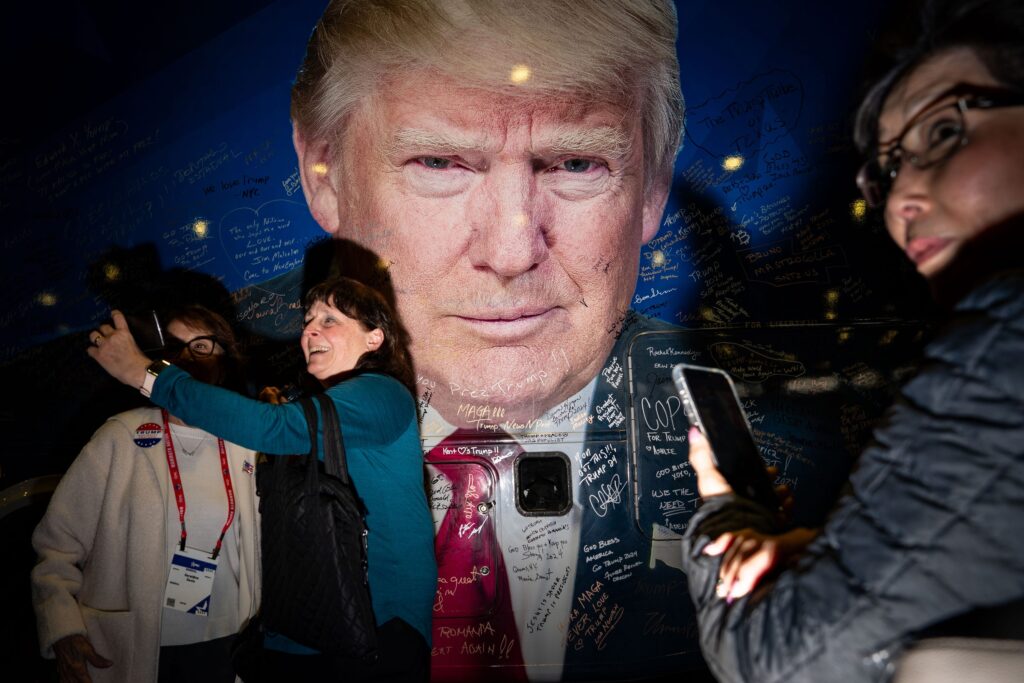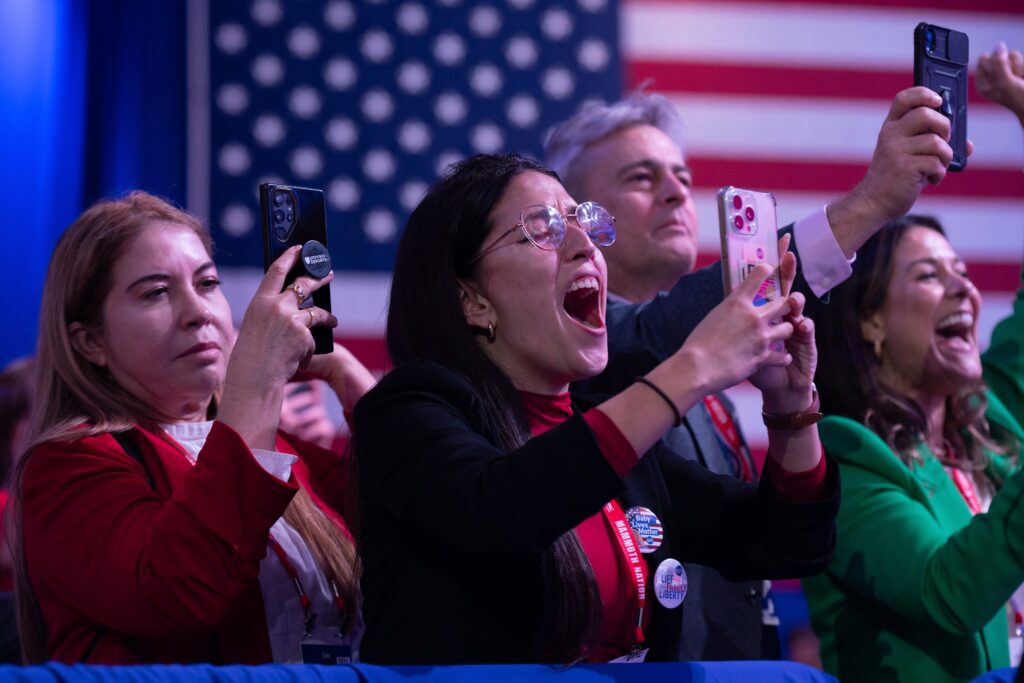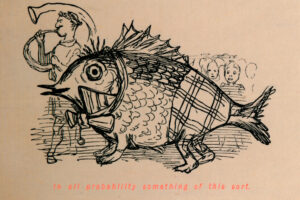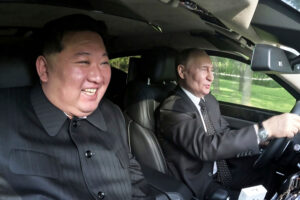CPAC Through a Latin American Lens

For an Argentine journalist that covers the far right, attending the Conservative Action Political Action Conference (CPAC) annual meeting felt akin to attending a Disney theme park for the first time. All the characters are together; it’s a chance to see the faces and hear the speeches, to mingle with the local fans—in other words, access to the real experience. That it is an election year only adds to the excitement. And this year’s gathering also boasted a familiar face: Javier Milei, Argentina’s brand-new president, was one of the international guest stars.
Helped by my president’s popularity, my accent was a ticket to hallway conversations and unexpected friends during the four-day summit, held at the Gaylord Convention Center in Maryland. Steve Bannon, the right-wing guru, kicked off the event with a five-hour seminar, and bookended it with the closing speech. In between, a platoon of leaders and activists painted a dark diagnosis about the state of the country and energized the audience with the possibility of revenge for 2020 come this November, a theme stressed by former President Donald Trump in his Saturday performance, in which he combined his speech with scenes akin to a stand-up routine.
These were my highlights:
Chaos is the Agenda
Eight months out from an election in which the right has a relative advantage, CPAC’s agenda for discussion is a symptom of the transformation of the conservative movement in the Trump era. The only clear topic at the programmatic level was the need to dismantle the “Deep State.” Bannon made it clear at the kickoff seminar: Trumpism must prepare for an unprecedented downsizing of the federal bureaucracy while consolidating its own army of loyal civil servants, a task that appears in the pages of “Project 2025,” compiled by the Heritage Foundation (though speakers omitted the reference, at least as far as I heard).
Otherwise, the official conversation of the four-day summit can be divided into two main areas. First, the description of the battlefield. According to the story told at the summit, the United States is a country on the verge of extinction. It is threatened by the migratory crisis (allusions to an “invasion of immigrants” were often repeated), by the onslaught of the “radical left” or “the woke agenda” on culture, education, and social coexistence and, finally, by China, frequently mentioned in the most elaborate speeches. Seen from the outside, and beyond the ideological seasoning, the United States appears in the lens of CPAC’s protagonists as a power in decline.
In that context, conservatives (informally described as “patriots,” the label preferred by the attendees I spoke with) identify themselves as a politically, judicially, and culturally persecuted majority. “It’s a leftist world,” said Megyn Kelly, the former Fox News anchor, when asked by Mercedes Schlapp about how she raises her children in these troubled times. The left, according to the story, controls Washington, the courts, sports, Hollywood and especially the universities, one of the main targets of attack at the summit. All the talks were preceded by the same video showing scenes of antisemitism on different campuses, a performance intended to represent unalloyed support for Israel along with the “dangers” of progressive discourse (there was, however, not a single sympathetic mention of Ukraine). One talk was entitled: Would Moses Go To Harvard (of course, the obvious answer is no).
None of these ideas—that the left controls Hollywood, that conservatives are persecuted by urbanite liberals—is new. The American right, including its neoconservative facet, has been articulating this vision for decades. What is new is how that narrative quickly became tied to a possibility of redemption. None of the descriptions of the catastrophic state of the country omitted the perspective that the day of reckoning is nigh—that the chance to remedy the loss lies just ahead in November.
That scenario almost took for granted the idea of a battle—a motto also repeated in the speeches. Both speakers and attendees were convinced that “the electoral fraud of 2020” would be repeated in this election, on a larger scale, which could include violence. The harangues transcended the electoral terrain: it was a battle—the definitive one—to recover the country. Perhaps that is also why the content of the “battle” was described in vague terms. Most of them mentioned it, but no one said how they defined the term: Is it a battle to reinforce electoral oversight? To mobilize more people to the streets? Or is it literal physical combat, akin to civil war? It was not clear.
The picture was completed by attendees. Several devoted Trump followers had traveled to the event, wearing T-shirts or beanies alluding to the former president. They came alone or in groups and seemed to enjoy the whole experience. There were also a good number of activists and political novices who took advantage of the event to socialize. Others were there to spread their cause, tell their stories: A Georgia reverend who had been accused of intimidating a female poll worker in 2020. A former military officer whose career had allegedly been ruined for refusing the Covid vaccine. The mother of the girl killed by police in the attack on the Capitol on January 6, 2021.
For many Americans, Jan. 6 is an open wound, an attack on the democratic system. But for this group the date also carries a pain-associated burden. It is as if the 2020 election cycle has not closed. In addition to the defeat (unjust, according to their narrative), there is an unhealthy serving of trauma, judicial cases and even felled heroes. Some participants approached them and expressed their gratitude and admiration. In their view these were good people whose lives were ruined in the defense of the United States.
And just one man can help them.
Trump, the savior
Marty, a retired nurse from Virginia who had traveled to CPAC with a friend, and who served as my constant confidante during the summit, explained it to me: “Trump is an experience.” For her, her connection to the former president transcended the election cycle, and it was the first time she had ever experienced anything like it. Her political debut dates to the Vietnam War, when she was a student, and a decade ago she had attended a few Tea Party rallies in her district. But Trump, she told me, “is something else.” Marty’s arrival in the MAGA movement had brought a renewed vitality to her routine and was also a way to occupy the time. The “experience” includes trips like these, the chance to share them with friends, and also things that are theoretically smaller, but still important to her, like buying Trump t-shirts and hats everywhere she goes, for herself, her son, and her husband. An important moment of the summit happened every morning, when she had to choose her attire. The first day she wore a T-shirt with the slogan “Education is not indoctrination.” On the last day, the most important because Trump was speaking, she wore a red one with the phrase: “If you don’t like Trump, you won’t like me.”
Another attendee, a risk analyst named Edward, who lived in New Jersey, told me that “Trump was sent by a merciful god to preserve Abraham Lincoln’s promise: ‘that government of the people, by the people, for the people, shall not perish from the earth.’ If Trump is elected, maybe this country can be saved. He is our last hope.” A convert to evangelicalism in recent years, his connection to the former president was akin to a religious experience.
Eight years after his irruption, such displays of Trump worship are no surprise to local observers, although for an outsider it may be shocking to witness in person. It is clear that the kind of connection the former president generates among his base goes beyond the vote and is especially significant among the white and evangelical population.
What is perhaps striking is how Trump’s leadership of the party remained intact and was even reinforced by the many felony charges filed against him, an omnipresent theme at the event. Former Trump rivals, such as journalist Megyn Kelly, presented themselves as acerbic critics of the “persecution.” Every speech by Republican politicians mentioned the former president in some way, something that should come as no surprise given CPAC’s mutation into a MAGA convention today.
The entire event orbited around Trump’s figure. There were curiously few traces of the Republican Party. The summit infrastructure—from merchandising to voter outreach and media—had no connection to any partisan agenda. Participants were either part of traditional conservative activism with a more radical bent, whether on abortion issues or religious faith, or they were part of the new far-right ecosystem, with its influencers and “anti-woke” activists. The summit epitomized how this new radical ecosystem has coopted the GOP.
This came into focus on Saturday, when Trump arrived. The speeches that preceded him emphasized him even more. The room was more packed. And the costumes had become more colorful and creative. An hour and a half before he started, the rest of the speeches were interrupted to make way for a musical preview with songs from Metallica to Abba. I was surprised by the heterogeneity of the audience: from retirees from the interior of the United States to teenagers dressed in red beanies, members of the crowd were united in dancing and having fun waiting for Trump. His remarks combined themes of revenge with mockery of Biden and narrations of presidential scenes, in a tone befitting a stand-up comedy monologue.
Following the summit, a group gathered to watch the results of the South Carolina primary, which had been held that day. Trump had swept again, and this time in the home state of his last remaining GOP competitor. The crowd was ecstatic. It was a tailor-made finish.

Milei, the new star
Milei’s strong gravitational pull on U.S. far-right ecosystem—a historical novelty—was notable at CPAC. I heard praise for Milei from the beginning of the summit, among attendees, influencers, and heavyweights. Trump mentioned him in his first acknowledgements in his speech. “He is MAGA,” he said. Mercedes Schlapp, one of CPAC’s hosts, explained to me that Milei was an “international sensation who connected with the American people,” adding that both Milei and El Salvador President Nayib Bukele had been invited as a nod to the growing importance of the Latino vote to Republicans.
“We love him. He’s fantastic,” Bannon told me of Milei, who was greeted with cheers from the audience despite his speech being too technical, boring, and lost in translation. Beyond the fact that both Milei and Trumpism adhere to the “culture war” narrative against the left, the Argentine leader does not have many other points of contact. He is not a nativist and his view of the economy, with excessive emphasis on the free market, may clash with Trump’s. Nor does he have a marked evangelical anchor, as was the case with Jair Bolsonaro in Brazil.
In a sense, Trump, Bukele and Milei represent three distinct variants of the far-right family in the hemisphere. Trump represents the nativist type, built on a strong religious influence that flirts with racial supremacy. Bukele, beyond his local particularity, has won regional admirers for his iron-fist policies, a punitive populism that resonates in places besieged by insecurity. Milei, on the other hand, seems to represent a new variant marked by free market radicalism, with a strong rejection of the state and its drivers: the political class. In a region marked by a crisis of representation, Milei’s battle cry also resonates.
The brief conversation I had with the far-right guru helped me understand something new: For Bannon, Milei’s chainsaw image—a concept the Argentine leader uses to sell his program of austerity—had resonated in the United States. “He’s fighting the Deep State just like we are,” Bannon told me. Milei’s narrative and program connected with the Trumpist priority of getting rid of the administrative state.
That narrative could guarantee Milei’s transcendence in the far-right ecosystem, beyond the still uncertain results of his presidency. Britain’s Liz Truss, who lasted less than 45 days as prime minister, was at the summit presenting herself as a Deep State victim whose program had suffered a backlash from Biden, the IMF and even big business—a striking statement given that her program proposed, among other things, a brutal tax cut. If Truss could rehabilitate herself, Milei might well pull a similar rabbit out of his hat.
The Argentine president made the pilgrimage to CPAC to worship Trump just a day after meeting with U.S. Secretary of State Antony Blinken. Milei seems to feel increasingly comfortable in such spaces. His participation at the summit also served to double down on the bet that his government is making on a Trump victory in November—a scenario that looks possible, but that could also be tinged with violence in the event of another electoral defeat. That is an eventuality that, as I learned during the four-day course of the conference, a significant portion of the U.S. right is already preparing for.


